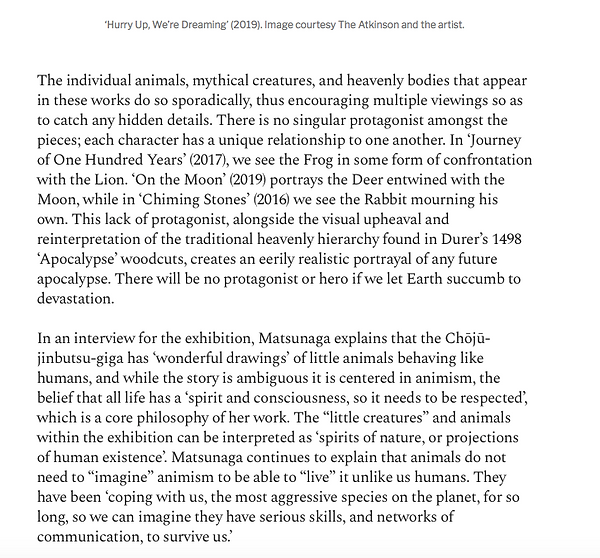




"In Search ofAuthentic Apocalypticism: Explorations of the Apocalypse in Contemporary Culture, Art and Literature" by Natasha O'Hear
Presented at Apocalypse and Authenticity Conference, 11-13 July 2017

Matsunaga’s image has at its core a desire to reinterpret the apocalypse from an animist, non-human perspective. Made as part of a series of drypoint etchings which have not been exhibited yet, the series was inspired by Durer’s Apocalypse woodcuts from 1498. Many have attempted copies and re-workings of this series, most notably Lucas Cranach the Elder’s polemical re-working for Luther’s New Testament of 1522.
In Durer’s version of the Four Horsemen, which is a fairly literal response to Revelation 6. 2-8, the Four Horsemen ride out in unison from the left to the right of the image, their presence as bringers of divine judgement both heralded and sanctioned by the angel in the top right hand corner. At the bottom of the image the Horsemen’s’ human victims are depicted, with some making futile gestures of resistance. Matsunaga deconstructs Durer’s image and subverts it, whilst simultaneously retaining the broad narrative structure and many of the same design and artistic features. Inspired by the animist belief that humans have wrongly assumed a position at the top of the world hierarchy, Matsunaga has replaced the human riders with animals and mythological creatures and deconstructed their rigid formation. Thus at the top of her image a frog and a mythological creature ride horses that themselves appear to be hybrid versions of horses and cloven hooved animals. The riders retain the bow and scale motifs of the first and third horsemen from the Durer image, although here the scales are tied to the third horse’s tail, rather than being held by the rider. This reduced group of horsemen also gallop from right to left rather than left to right and the second horse is a barely visible two legs in the top left of the image. The fourth horse and rider, the most striking figure in the Durer image and which has had a wide iconographic influence has been strikingly transformed by Matsunaga into a snail being ridden by a rabbit or hare. The established iconographic symbol of the fourth rider, the pitchfork, lies bent and broken on the ground. And in another fascinating alteration, the fourth horseman (snailman?) pursues one of Durer’s angels rather than a human victim.
As stated earlier, Matsunaga states that her impetus for creating the series was to explore the notion of apocalypse from an animist perspective. At its essence animism, which is the oldest known belief system and is still inherent to many indigenous cultures today, is the belief that all creatures, objects and places are animated and alive, have a distinct spiritual essence and possess agency. An animist apocalypse would therefore have to consider the effect of that apocalypse on animals and objects as well as humans, as well as the role that they might play in it. In Matsunaga’s image therefore the apocalypse is construed as something much bigger than just a purely human phenomenon. In fact, humans have been edited out of this particular image (if one discounts the angel), thoroughly discrediting the idea that humans have some kind of special existence on earth. Here it is the animals and mythical creatures who are the source of the apocalyptic judgement, although whether they are solely harbingers of doom or also of blessing is also left ambiguous. The very notion of judgement itself is turned on its head when the rigidly hierarchical model of the monotheistic religions is subverted by an animist philosophy. What does apocalyptic judgement look like if it doesn't flow from a divine lawgiver? In conversation with Matsunaga, she has also hinted that there is an element of ecological critique present in this series. Certainly the implied wider critique at work in this series is the notion that human disregard for the non-human world will lead to the natural world striking back in unpredictable and potentially catastrophic ways.
Review
in Corridor 8
by Katie Shirley








"Art and Museum" Summer 2021 publication











